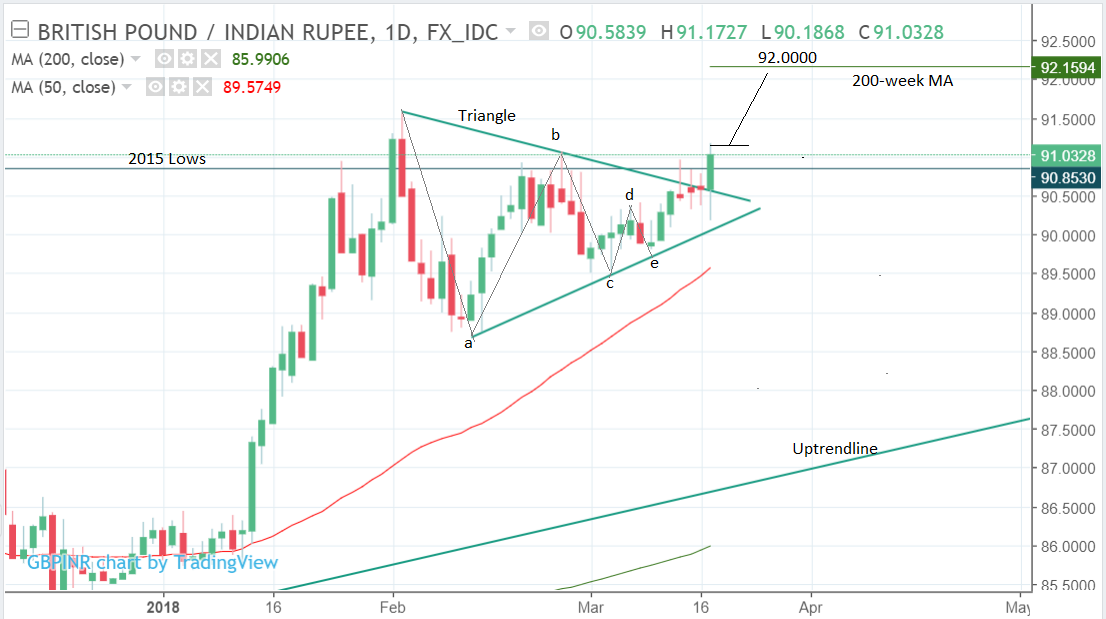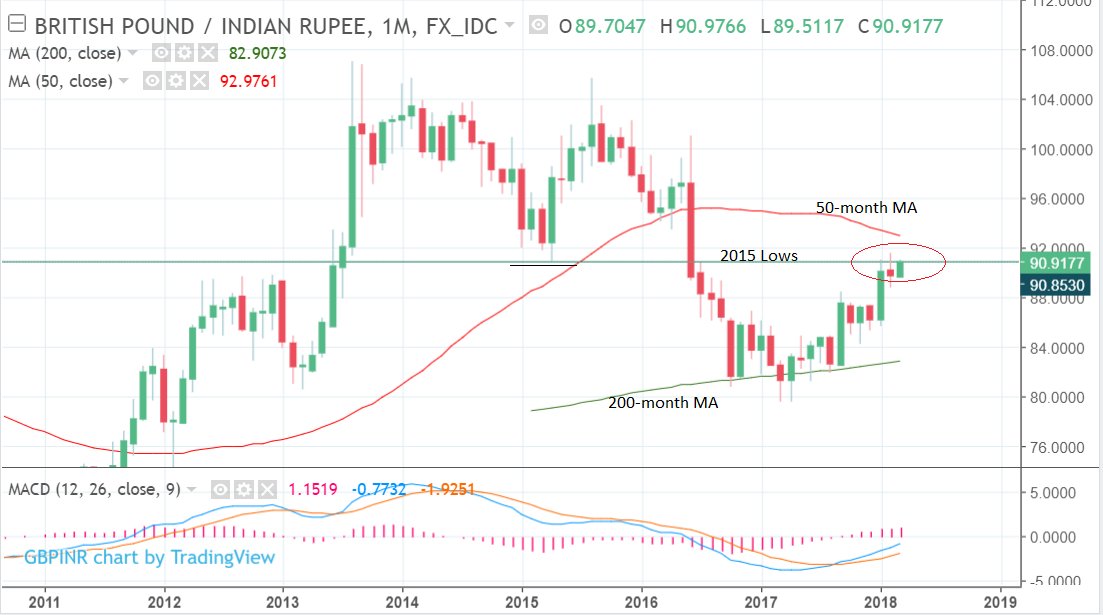Pound-to-Indian Rupee Rate's Forecast For The Week Ahead

© Andrey Popov, Adobe Stock
GBP/INR is surging higher on an improved outlook for Sterling as Brexit negotiations show progress; on the charts, the pair breaks out of a narrow range.
GBP/INR is breaking out of what looks very much like a triangle chart pattern (see below) as Brexit negotiations appear to be going more smoothly according to reports on Monday morning.
The breakout has bullish implications for the pair and suggests a move higher will follow, up to 92.00 and the realm of the 200-week moving average (MA) (at 92.1594).
The pair has actually already pierced the upper boundary line of the triangle at about 90.50 and broken successfully above the March 14, 91.00 highs, thus providing confirmation of a successful breakout.
We now forecast a continuation up to the 92.00.
The pair had been bumping up against tough resistance at the 2015 lows (circled below), situated at 90.85, for quite sometime now, but it looks like this too have been breached, lending further fuel to the uptrend.
Often major highs and lows comprise obstacles to the dominant trend and prices often stall, pull-back or even reverse when they touch them.
The fact GBP/INR has broken above the 2015 lows is, therefore, a very positive sign for the uptrend and shows renewed confidence.
Major lows attract short-term technical traders seeking to exploit the expected pull-back as a profit opportunity.
Investors who misjudged the major low also often see a retouch as a second chance to get out of their long-term losing position and breakeven, thus further increasing volatility around the level.
Get up to 5% more foreign exchange by using a specialist provider to get closer to the real market rate and avoid the gaping spreads charged by your bank when providing currency. Learn more here.
Data and Events to Watch for the Rupee
There are no major releases for the Rupee in the coming week but recent subdued inflation data, due to a reversal in food price spikes, is increasing speculation of a 0.25% cut in interest rates from the Reserve Bank of India (RBI) in the summer.
Such a cut would be expected to weigh on the Rupee as it would reduce foreign capital inflows, which tend to be drawn by the promise of higher not lower interest returns.
"We grow more confident of our standing call of a 25bp (%) RBI rate cut in August, if rains are normal, to signal lending rate cuts to support growth. Inflation slid to a lower-than-expected 4.4% in February from 5.1% in January, with the tomato and onion price spike reversing. Core inflation remains a benign 4.3%," says Bank of America Merrill Lynch.
Thus the slightly negative fundamental outlook for INR supports the more positive technical outlook for GBP/INR, assuming the Pound continues to gain favour, which heavily depends on the course of Brexit negotiations.
Data and Events to Watch for the Pound
It is a busy week for UK data with the highlight being the EU summit on March 22-23 which will determine whether the EU and UK will enter a two-year 'transition period' after the official Brexit deadline has passed in March 2019.
A transition period keeps trade settings between the EU and UK more or less unchanged and helps businesses avoid the spectre of a cliff-edge Brexit in 2019 which would see the trade relationship default to World Trade Organisation (WTO) rules tariffs.
The Pound's fate in the coming weeks thus depends very much on whether a transition agreement can be approved.
"If negotiations do indeed proceed in line with the scheduled timetable, this should help to reassure investors that a final deal is indeed possible which should have some upside for the Pound," says a note from global investment bank Investec.
Markets are quietly confident a deal will indeed been reached based on the hints that have been coming through in recent days, Robin Walker - who serves as Parliamentary Under Secretary of State at the Department for Exiting the European Union - said in a speech at the Institute of Directors last week that "we recognise how important it is to secure the deal on the implementation period as soon as possible. I want to stress that we are very close to a deal at this time.”
“Both the prospect and the timing of a transitional deal on Brexit remain highly uncertain. If such a deal does take place, however, it could be an important positive development for Sterling in the near-term by reducing 'cliff-edge' risks," says Lefteris Farmakis, an FX strategist at UBS Group.
However, the issue of the Irish border remains a thorny issue that has long appeared to be at an impasse, and it could yet come to deliver disappointment so nerves will remain elevated.
The other major event for the Pound is the Bank of England (BOE) rate meeting on Thursday at 12.00 GMT.
Although no-change in policy is expected analysts will be carefully combing the meeting minutes, released after the meeting, for signs of which way the monetary policy committee (MPC) appears to be swaying when it comes to future policy.
At the previous meeting, the BOE said they thought markets were underestimating how close the BOE was to increasing interest rates and analysts will be watching for whether this is still the case, according to Nordea Bank's chief analyst Martin Enlund et al.
Much depends on whether the BOE decides to keep the new phrase introduced in its last policy statement that, "monetary policy would need to be tightened somewhat earlier and by a somewhat greater degree over the forecast period."
If the phrase is kept in then it would indicate a greater urgency to raise interest rates than currently expected and result in upside for the Pound.
Higher interest rates are generally bullish for a currency as they increase inflows of foreign capital drawn by the promise of higher returns.
Another major release in the week ahead for the Pound is inflation data out on 9.30 on Tuesday, and this is forecast to show a slow-down in the rate of inflation to 2.8% year-on-year in February, i.e compared to a year ago, from 3.0% in the previous month.
On a monthly basis, it is forecast to show a 0.5% rise from a -0.5% in the previous month of January.
Normally high inflation stimulates currency appreciation because it suggests interest rates will rise, especially if it is caused by stronger growth, but because UK inflation has been caused predominantly by the weak Pound increasing the price of imports rather than growth, the relationship is a little more complex and the Pound may act unpredictably after the release.
Wednesday sees the release of UK labour market data which could also impact on the Pound - if labour data is positive, especially wage data, it is likely to strengthen Sterling.
Average Earnings are forecast to rise to 2.6% in January from 2.5% in December - both including and excluding bonuses - and if this occurs it could provide an impetus to the Pound.
The unemployment rate is forecast to stay unchanged at 4.4% and employment change to show that an extra 85k more jobs were added to the economy when the data is released at 9.30 on Wednesday morning.
Thursday sees the release of another potentially market-moving release in the form of Retail Sales, which is forecast to show a 1.5% rise yoy in February from 1.6% previously and 0.4% month-on-month from 0.1% in January.
Get up to 5% more foreign exchange by using a specialist provider to get closer to the real market rate and avoid the gaping spreads charged by your bank when providing currency. Learn more here.


